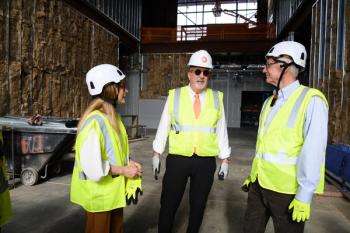
Your manager can be your hospital construction lifeline
Learn how your practice manager can help to make your building dreams come true.
Just 14 days after accepting the job of practice manager at Meadow Hills Veterinary Center in Kennewick, Wash., Brian Conrad, CVPM, jumped feet-first into a building project. Looking back on that experience, Conrad, who by this point has been practice manager for 11 years, jokes that the owners basically gave him a lawn chair and planted him at the construction site. With groundbreaking just two weeks away, the doctors had already done the bulk of the legwork. Nine years later, Conrad found himself involved in yet another huge construction project.
But as an experienced manager, Conrad’s role was a whole lot different. What he learned from these two building experiences can save practice owners and managers alike a lot of headache, heartache, and trouble.
What to expect when you’re expecting to build
As a two-time veteran of the hospital building experience, Conrad’s number-one piece of advice is this: Communicate, communicate, communicate. “There are no set rules for how involved a practice manager should be,” he says. “Some work with architects, bankers, and builders; others have nothing to do with the process except showing up on move-in day. Practice owners and managers need to be proactive and have that talk about what role the manager will take, then keep talking.”
Managers shouldn’t be afraid to bring up the subject as soon as they get word that a building project is on the horizon. “Ask, ‘What kind of role do you want me to play?’” Conrad says. “And, ‘How can I help you make this project happen?’ Then be flexible and dependable, and get the job done.”
The hats a manager wears
In addition to his normal management duties, Conrad took on the following jobs. Consider each one carefully and determine how involved the manager will be at your practice.
Researcher. Before any walls go up, the practice must purchase equipment, which requires lots of research. Conrad did his homework. He looked for equipment to suit the practice and made sure the pieces would fit in the space allotted in the new building. He investigated warranties, building workflow, and much more. “This is one place a manager can really show his or her worth, and it’s important not to cut corners,” Conrad says.
Staff liaison. This one’s big when your team is facing a building project. For starters, the manager can gather input from employees on what they need or would like to see in the future facility in terms of workflow and equipment. The practice manager can compile the ideas and present them to the practice owners, leaving the owners more time to, say, treat pets.
Conrad also learned during his second building project that it’s crucial to take team members to the work site throughout the process. “Giving staff members ownership from the start means they’ll be much more positive about the change,” he says. From time to time, Conrad gathered up a few staff members, grabbed some coffee or ice cream on the road, and headed out to the site. He would walk the team members through the facility at various stages, gather input about how things would work, and solicit any ideas to improve the plan.
“At the end of our first building project, I remember the owners taking the staff over to see the nearly finished building,” he says. “We had an ice cream bar set up for a staff meeting, and the owners were incredibly excited to show off the heart and soul of their work. Unfortunately, there were some complaints about the way things had been done. Staff members weren’t invested in the project and just wanted their ideas heard. We learned from that for our second time around.”
Marketing manager. Getting word out about your facility is vital, Conrad says. And you need to start early—even before breaking ground—to get the best response and support from the community. At Meadow Hills, Conrad organized a groundbreaking ceremony with 200 guests. The event included a Chamber of Commerce ribbon cutting and an open house. And, of course, he invited the media.
To keep clients and the community informed throughout the building process, Conrad posted progress reports and pictures on the practice website. Closer to opening day, he hosted a number of “VIP nights” to give a sneak peek of the developing facility to team members and their families, professionals who were a part of the project, pet adoption organizations, and dog training groups.
Inventory chief. When the new building is nearly complete, it’s time to take stock of inventory on hand. A larger facility usually means more supplies—and someone has to evaluate those needs and determine the best buys for your specific practice. This is a great job to delegate to the manager, Conrad says.
Maintenance contract negotiator. All the new medical equipment, freshly planted landscaping, and building systems need to be maintained, and who better to handle those maintenance contracts than the practice manager? The manager can prepare maintenance contracts, organize files, and prepare phone lists for team members specifying who to call when something goes wrong (plumbing, IT, and so on). Because, let’s face it, they often do.
Safety sergeant. New safety plans need to be prepared for the new facility. Fire routes and emergency meeting places will be different, and the security system—with key fobs, codes, or old-fashioned keys—needs to be explained to the entire team. Any new chemicals and products that will be used in the new building need to be included in the clinic’s updated material safety data sheets. Again, these are all things the practice manager can handle.
Keeper of the punch list. The final punch list—a list of to-do items for the construction team—is a big deal and, for many practices, a really big headache. Conrad says that seven months after opening the new facility, he’s still working on getting everything finalized. “It’s a big job keeping after the contractors to get every little thing done,” he says. “But by taking care of this stuff, I can help the practice owners get back to caring for patients.”
Keeping conflict at bay
Now, all that said, there has to be give and take to make the job reasonable. A practice manager can’t take over the building project and keep the daily business afloat alone, but he or she can work alongside the owners to smooth the transition. And it’s inevitable that there will be some conflict along the way.
Conrad goes back to his first piece of advice: “Communicate, communicate, communicate.” And while it’s important for the practice owners to see the manager’s side of things, the manager also needs to keep things in perspective. The owners are signing their lives away for this new building, Conrad says. It’s their reputation on the line, and their dream for the future. “So when there’s conflict over how something should be handled, the manager needs to remember that it’s the owner’s project,” Conrad says. “You’re just there to facilitate a smooth experience however you can.
It’s helpful for the manager to have the right mindset. Yes, it’s going to be a crazy year or so, and, yes, the workload will increase. “But it’s exciting to help mold a project knowing you’re building a better work area for clients and staff, knowing the hospital will grow so there will be more opportunities for you to grow, and seeing the financial benefits along the way,” Conrad says.
Sarah Moser is a freelance writer and editor in Lenexa, Kan. E-mail comments or questions to
Continue on for great photos of Brian Conrad's hospital from groundbreaking to completion ...
Photos courtesy of Brian Conrad
Marketing manager: Practice manager Brian Conrad (not pictured) publicized his hospital's groundbreaking, drawing local press and more than 200 clients, residents, and community leaders.
Photos courtesy of Brian Conrad
Photos courtesy of Brian Conrad
Photos courtesy of Brian Conrad
Photos courtesy of Brian Conrad
Photos courtesy of Brian Conrad
Staff liaison: During and after the building's construction, Conrad acted as staff liaison, taking handfuls of employees to the site and the unfinished building throughout the construction process to gather ideas along the way from the team members who would be working in the finished clinic.
Photos courtesy of Brian Conrad
Researcher: Before these walls went up, Conrad research equipment, building workflow, and more for the practice owners.
Photos courtesy of Brian Conrad
Maintenance contract negotiator: If wiring went bad, Conrad was the one who knew what to do. He found out what warranties covered in the new building and who to call when something was on the fritz.
Newsletter
From exam room tips to practice management insights, get trusted veterinary news delivered straight to your inbox—subscribe to dvm360.






